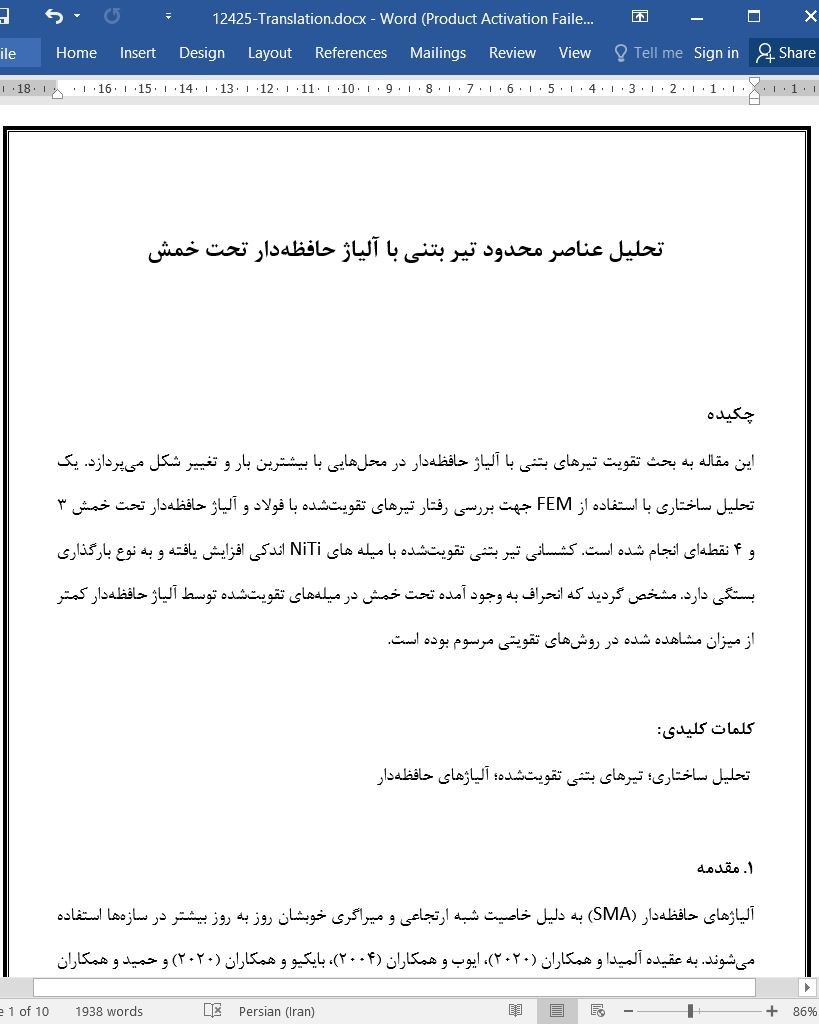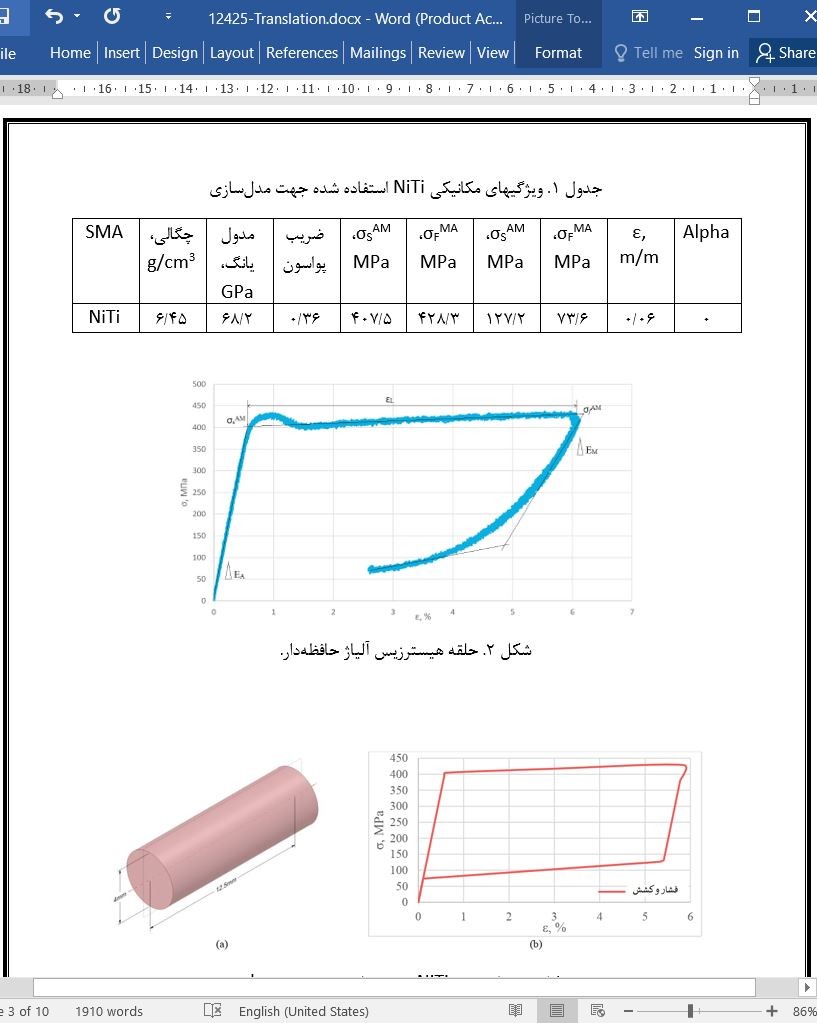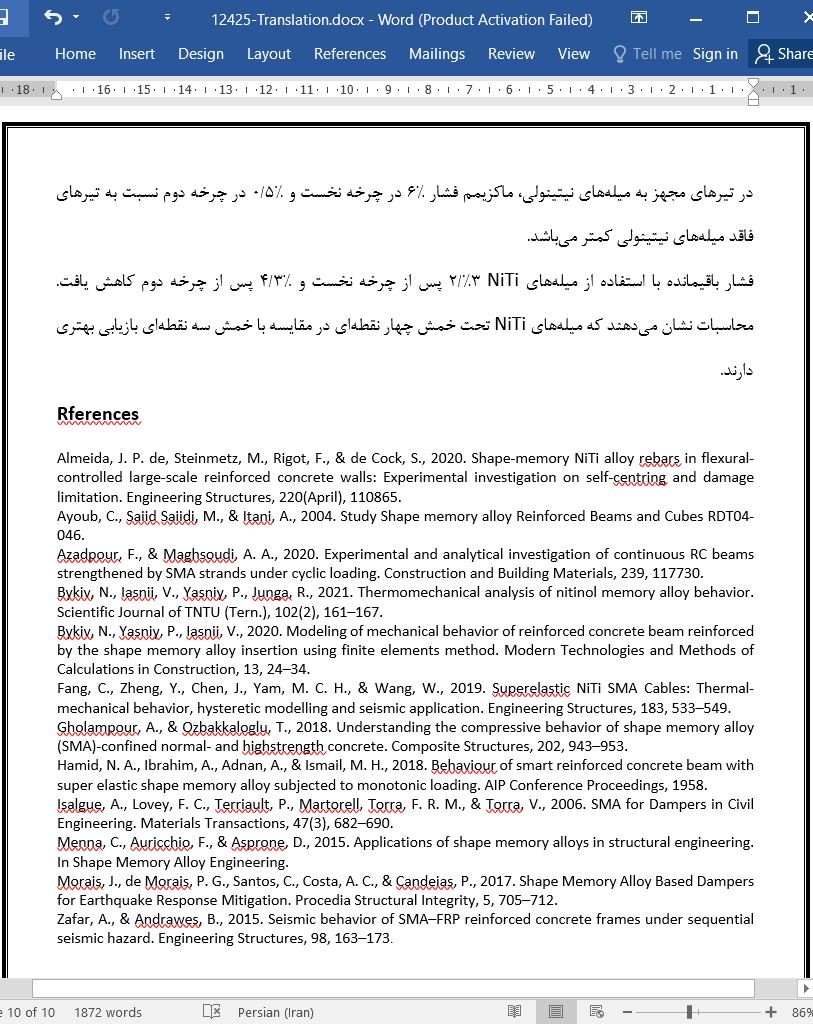
تحلیل عناصر محدود تیر بتنی با آلیاژ حافظه دار تحت خمش
چکیده
این مقاله به بحث تقویت تیرهای بتنی با آلیاژ حافظه دار در محل هایی با بیشترین بار و تغییر شکل می پردازد. یک تحلیل ساختاری با استفاده از FEM جهت بررسی رفتار تیرهای تقویت شده با فولاد و آلیاژ حافظه دار تحت خمش 3 و 4 نقطه ای انجام شده است. کشسانی تیر بتنی تقویت شده با میله های NiTi اندکی افزایش یافته و به نوع بارگذاری بستگی دارد. مشخص گردید که انحراف به وجود آمده تحت خمش در میله های تقویت شده توسط آلیاژ حافظه دار کمتر از میزان مشاهده شده در روش های تقویتی مرسوم بوده است.
1. مقدمه
آلیاژهای حافظه دار (SMA) به دلیل خاصیت شبه ارتجاعی و میراگری خوبشان روز به روز بیشتر در سازه ها استفاده می شوند. به عقیده آلمیدا و همکاران (2020)، ایوب و همکاران (2004)، بایکیو و همکاران (2020) و حمید و همکاران (2018)، SMA ظرفیت باری سازه ها و یا عناصر آنان را تحت فشار استاتیک را افزایش می دهد. SMA به دلیل خاصیت میراگری خوبش به عنوان عنصر اصلی ابزار جهت کاهش بار دینامیک در سازه های منا و همکاران (2015) و علی الخصوص پل های ساخته شده توسط فنگ و همکاران (2019) به کار برده شده است. به علاوه از SMA می توان به عنوان گزینه جایگزین جهت تقویت سازه ها و یا عناصر آنان در مناطق زلزله خیز استفاده کرد، ایسالگ و همکاران (2006)، مورایس و همکاران (2017)، ظفر و آندراوس (2015).
4. نتیجه گیری
کشسانی تیرهای بتنی تقویت شده با میله های NiTi کمی افزایش یافته و به نوع بارگذاری بستگی دارد. هرچند، انحرافات باقیمانده در خمش سه نقطه ای %24 و در خمش چهار نقطه ای %27 در مقایسه با روش های تقویتی مرسوم کاهش می یابد.
در تیرهای مجهز به میله های نیتینولی، ماکزیمم فشار %6 در چرخه نخست و %5/0 در چرخه دوم نسبت به تیرهای فاقد میله های نیتینولی کمتر می باشد.
فشار باقیمانده با استفاده از میله های NiTi %3/2 پس از چرخه نخست و %3/4 پس از چرخه دوم کاهش یافت. محاسبات نشان می دهند که میله های NiTi تحت خمش چهار نقطه ای در مقایسه با خمش سه نقطه ای بازیابی بهتری دارند.
Abstract
The paper deals with strengthening of the reinforced concrete beam by shape memory alloy at the place of maximum loading and deformation. A structural analysis is performed using FEM to study the behavior of the beam reinforced by steel and shape memory alloys under 3- and 4-point bending. The elasticity of the reinforced concrete beam with NiTi rods slightly increase and depends on loading type. It was revealed, that under the bending in the beam reinforced by shape memory alloy the residual deflection decreases in comparison with traditional reinforcement.
. Introduction
Shape memory alloys (SMA), due to their pseudoelastic and good damping properties, are increasingly using in structures. SMA improve the load-bearing capacity of structures or their individual elements under static load by Almeida et al. (2020); Ayoub et al. (2004); Bykiv et al. (2020); Hamid et al. (2018). Due to high damping properties SMA are employed as the main elements in the devices to decrease the dynamic loadings of the structures by Menna et al. (2015) bridges in particular by Fang et al. (2019). Besides, SMA are considered to be the alternative strengthening of the structures or their elements being in operation in the seismic regions by Isalgue et al. (2006); Morais et al. (2017); Zafar and Andrawes (2015).
4. Conclusions
The elasticity of the reinforced concrete beam with NiTi rods slightly increase and depends of loading type. However, residual deflection reduces by 24% under 3-point bending and by 27% under 4-point bending in comparison with traditional reinforcement.
In the beam with nitinol rods, the maximum stresses are higher by 6% in the first cycle and 0.5% in the second cycle, but the residual stresses are lower by 2.3% in the first cycle and 4.3% in the second cycle, compared to the beam without nitinol rods.
Residual stresses decreased using NiTi rods by 2.3% after the first cycle; 4.3% after the second cycle. It was estimated that under 4-point bending, NiTi rods showed a better recovery effect in comparison with 3-point bending
چکیده
1. مقدمه
2. مواد و روش ها
3. نتایج و بحث
4. نتیجه گیری
منابع
Abstract
1. Introduction
2. Materials and methods
3. Results and discussions
4. Conclusions
Rferences
- اصل مقاله انگلیسی با فرمت ورد (word) با قابلیت ویرایش
- ترجمه فارسی مقاله با فرمت ورد (word) با قابلیت ویرایش، بدون آرم سایت ای ترجمه
- ترجمه فارسی مقاله با فرمت pdf، بدون آرم سایت ای ترجمه



